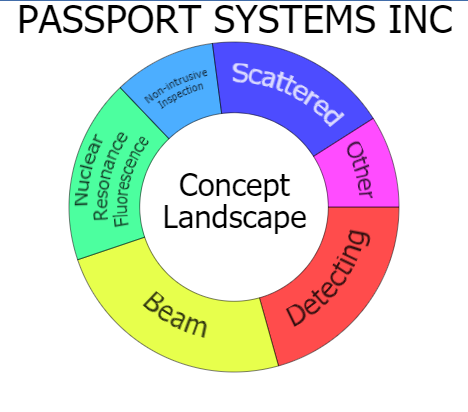Patent Backed Bankruptcy Report
Company Background:
Passport Systems Inc. designs and develops inspection/detection systems to address the threats facing the world in the aftermath of the 9/11 terrorist attacks. The company develops active and passive solutions to automatically detect, localize, and identify concealed threats and contraband for a range of applications, including pedestrian, vehicle, and fixed-facility based approaches. Its products include SmartScan 3D, a fixed cargo scanner for the automated clearing of non-threat cargo/vehicles and detection of threats in complex cargo, as well as manifest verification and/or investigation, and the detection of heavily shielded nuclear materials; and SmartShield, a networked radiation detection system for detecting and preventing the potential radiological threats. The company’s products are used for various applications, including national and international security improvement by clearing cargo of WMDs; contraband detection, manifest validation, and expedited inspection; global improvement of national security nuclear material controls; and real-time radiation threat monitoring, and protecting urban populations and large events. Passport Systems Inc. was founded in 2002 and is based in Billerica, Massachusetts.
Address
Ownership
Industry
70 Treble Cove Rd 1st Floor
North Billerica, MA 01862
Private
Security and Detection Services
Chapter Type | Case Number | Assets | Liabilities | Industry/Description |
7 | 4:2020bk41086 | $1 Mil – $10 Mil | $10 Mil – $50 Mil | Detection Systems |
Portfolio Valuation Range | Asset Valuation Range | Total Assets Valuation Range | Liability Range | Leverage Ratio Range |
$450,000 – $1.8 Mil | $500,000 – $10 Mil | $950,000 – $11.8 Mil | $50,000 – $375,000 | 2.53 – 236 |
Patent Portfolio Breakdown
18 Active US Patents

Featured Assets
Abstract:
Systems and methods are disclosed herein for lenses based on crystal X-ray diffraction and reflection to be used to direct and energy filter X-ray beams.
Claim 1:
1. A method for illuminating a target to analyze
its contents, comprising:
a)
providing a source of photons in an X-ray energy range including photons of
energy greater than 100 keV;
b)
locating a crystal lens comprised of a plurality of lens surfaces arranged in
at least one concentric circle, at a predetermined location relative to the
photon source such that a beam of photons from the photon source is incident on
said plurality of lens surfaces at at least one preselected angle of incidence
to the surfaces; and
c)
locating a target at a predetermined location relative to the crystal lens such
that a plurality of photons from the photon beam in a preselected energy range
are diffracted by the lens surfaces to be incident on a preselected portion of
the target;
further
comprising moving the target such that a plurality of the diffracted photons
scan at least a portion of a target surface.
Abstract:
Methods are
described wherein the signals from various sensors that monitor parameters such
as beam position, beam intensity at each turn, number of turns, extracted
current, extracted beam profile in space and energy are used to determine the
effect of the variation of different parameters that control the operation of
an accelerator. The diagnostic measurements and adjustments may be based upon
measuring and evaluating parameters as a function of turn, and are part of an
automated feedback loop for achieving the proper automated operation. The
methods can be used to establish proper operating values for the accelerator
parameters for optimum beam operation. By the use of feedback the operation of
the accelerator can be automatically controlled in real time.
Claim 1:
1. A method of controlling the operation of a
particle accelerator, comprising:
a) injecting a particle beam into the accelerator;
b) performing at least one injection phase diagnostic measurement;
c) based upon the at least one injection phase diagnostic measurement, determining if the particle beam has been successfully injected;
d) upon the particle beam not having been successfully injected, varying at least one injection phase control action, and repeating steps a) to c);
e) upon the particle beam having been successfully injected, performing at least one acceleration phase diagnostic measurement;
f) based upon the at least one acceleration phase diagnostic measurement,
determining if the particle beam has been successfully accelerated;
g) upon the particle beam not having been successfully accelerated, varying at
least one acceleration phase control action, and repeating steps a) and e) to
f);
h) upon the particle beam having been successfully accelerated, performing at
least one use phase diagnostic measurement;
i) based upon the at least one use phase diagnostic measurement, determining if
the particle beam has been successfully used;
j) upon the particle beam not having been successfully used, varying at least one use phase control action, and repeating steps a) and h) to i); and
k) upon the particle beam having been successfully used, further operating the
accelerator.
Abstract
A method for detecting nuclear species in a sample by adaptive scanning using
nuclear resonance fluorescence may comprise illuminating the target sample with photons from a source; detecting a signal in an energy channel; determining a scan evaluation parameter using the signal detected; determining whether the scan evaluation parameter meets a detection efficiency criterion; adjusting one or more system parameters such that the scan evaluation parameter meets the detection efficiency criterion; and comparing the signal in an energy channel to a predetermined species detection criterion to identify a species detection event. In another embodiment, detecting a signal in an energy channel may further comprise detecting photons scattered from the target sample. In another embodiment, detecting a signal in an energy channel may further comprise detecting photons transmitted through the target sample and scattered from at least one reference scatterer.
Claim 1:
method comprising:
a) providing a source of photons incident upon the target sample such that some photons are scattered from the target sample;
b) for at least one portion of interest in the target sample, determining if an incident photon beam intensity into said portion of interest is attenuated as a result of interactions between incident beam photons and portions of the target sample between the said portion of interest and an incident beam source such that the said incident photon beam intensity into the said portion of interest is below a desired flux;
c) if the incident photon beam intensity into the said portion of interest is below the desired flux, altering an angular orientation between the target sample and the incident photon beam such that the incident photon beam passes through different portions of the target sample than previously in reaching the portion of interest such that the attenuation of the incident photon beam intensity is reduced;
d) for the said at least one portion of interest in the target sample:
i) measuring an energy spectrum of photons scattered from the said at least one portion of interest in the target sample;
ii) using the energy spectrum of photons scattered from the said at least one portion of interest in the target sample to compute a detection probability and a probability of obtaining a false positive result;
iii) using the measured energy spectrum of photons scattered from the said at least one portion of interest in the target sample to determine whether an item of interest has been detected;
iv) if an item of interest has not been detected:
A) determining whether the detection probability meets or exceeds a predetermined desired detection probability;
B) if the detection probability meets or exceeds the predetermined desired detection probability, ending the scan for the said at least one portion of interest in the target sample; and
C) if the detection probability does not meet or exceed the predetermined desired detection probability, adjusting one or more system parameters and repeating steps (i) through (iv); and
v) if an item of interest has been detected:
A) determining whether the probability that the item of interest detection is a false positive signal exceeds a predetermined desired probability of obtaining a false positive result;
B) if the probability that the item of interest detection is a false positive signal meets or exceeds the predetermined desired probability of obtaining a false positive result, adjusting one or more system parameters and repeating steps (i) through (v); and
C) if the probability that the item of interest detection is a false positive signal does not meet or exceed the predetermined desired probability of obtaining a false positive result, identifying a positive item of interest detection event.
.
123 Town Square Place #419
Jersey City, NJ 07310


